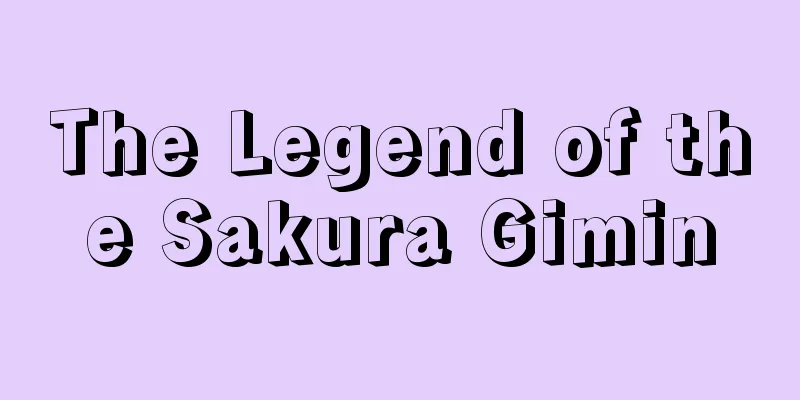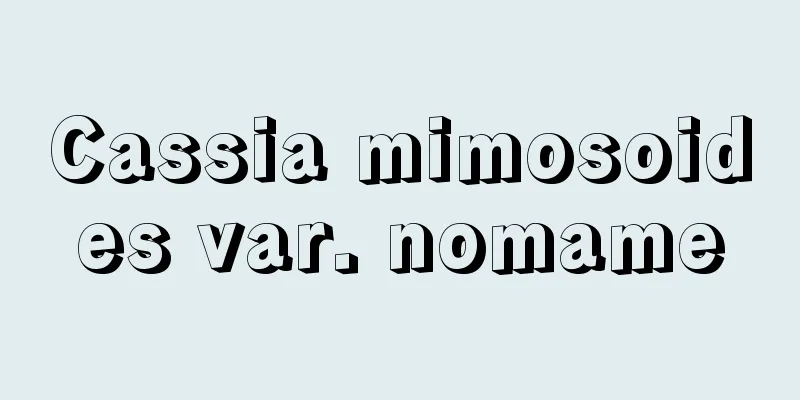The Legend of the Sakura Gimin

|
The subject and title of a Kabuki play, a Joruri play, and a storyteller. It is an adaptation of the deeds of the righteous Sogo Kinouchi, known by the name of Sakura Sogoro. It was first used in a book of facts and storytelling, and the first dramatization was "Higashiyama Sakura Soshi" by Segawa Joko III, which premiered at the Nakamuraza Theater in Edo in August 1851 (Kaei 4). Set against the backdrop of the Toyama period of the Muromachi Shogunate, it incorporates Ryutei Tanehiko's "Nise Murasaki Inaka Genji," adapting Sogo as Asakura Togo and Hotta Masanobu as Orikoshi Masatomo, and the play gained a good reputation for the excellent performance of the lead actor, Ichikawa Kodanji IV. Later, in 1861 (Bunkyu 1), Kawatake Mokuami revised the script, removing the plot from "Inaka Genji" and revising it under the title "Gonichi no Bundan: The Later Discourse of the Sakura Zhuangzi," which became the basis for the play. Although the title has changed several times since then, from the late Meiji period onwards, the characters' real names were used, and the title "Sakura Gimin Den" has remained the same to this day. Kinouchi Sogo, headman of Sakura in Shimousa (Chiba Prefecture), appealed to the Edo residence of the feudal lord Hotta Kozukenosuke to save the peasants suffering under his tyranny, but was unsuccessful. So he returned to his country and crossed the heavily guarded Inba Lake with the help of Mori Jinbei's chivalrous spirit. He said goodbye to his wife and children, then went back to Edo and appealed directly to the shogun at Kan'ei-ji Temple in Ueno. His wish was granted, but after Kozukenosuke had Sogo and his wife and children crucified, he was haunted by the ghosts of Sogo and his family, and the Hotta clan was eventually destroyed. This is a rare peasant drama in Kabuki. Although "Monso" and "Bukkoji," which depicts the prayers of Sogo's uncle Kozen, are occasionally performed, the three most famous scenes are "Ferry," "Sogo's Uchiko Wakare" and "Direct Appeal," and "Kowakare" is particularly famous for its effective use of snow to depict sorrow. Sogo was the hit act of the first Nakamura Kichiemon. [Toshiaki Matsui] Source: Shogakukan Encyclopedia Nipponica About Encyclopedia Nipponica Information | Legend |
|
歌舞伎(かぶき)、浄瑠璃(じょうるり)、講談の題材および演目名。佐倉惣五郎(そうごろう)の名で知られる義人木内宗吾(そうご)の事跡を脚色したもの。まず実録本や講談に扱われ、劇化の最初は1851年(嘉永4)8月江戸・中村座初演の3世瀬川如皐(じょこう)作『東山桜荘子(ひがしやまさくらそうし)』。室町幕府の東山時代を背景に、柳亭種彦(りゅうていたねひこ)の『偐紫田舎源氏(にせむらさきいなかげんじ)』を絡ませ、宗吾を浅倉当吾、堀田正信(ほったまさのぶ)を織越政知の名で脚色、主役の4世市川小団次(こだんじ)の好演で評判になった。のち1861年(文久1)河竹黙阿弥(もくあみ)が「田舎源氏」の筋を抜き『桜荘子後日文談(ごにちのぶんだん)』の名題(なだい)で補訂した脚本が基盤になり、その後も名題は種々変わったが、明治後期からは役名を実名どおりとし、名題も『佐倉義民伝』にほぼ定着して今日に至った。 下総(しもうさ)(千葉県)佐倉の名主木内宗吾は、領主堀田上野介(こうずけのすけ)の暴政に苦しむ農民を救うため、江戸屋敷に門訴したが、不成功に終わったので、いったん国へ帰り、監視厳しい印旛(いんば)沼を渡し守甚兵衛の義侠(ぎきょう)で渡って、妻子に別れを告げ、ふたたび江戸へ上り、上野・寛永(かんえい)寺で将軍に直訴する。願いはかなえられるが、上野介は宗吾を妻子もろとも磔刑(はりつけ)に処したあと、宗吾一家の亡霊に悩まされ、ついに堀田家は滅びる。歌舞伎に珍しい農民劇。まれに「門訴」や宗吾の叔父光然(こうぜん)の祈りを描いた「仏光寺」が上演されるが、有名なのは「渡し場」「宗吾内子別れ」「直訴」の3場で、とくに「子別れ」は雪を効果的に使った愁嘆場として名高い。宗吾は初代中村吉右衛門(きちえもん)の当り芸であった。 [松井俊諭] 出典 小学館 日本大百科全書(ニッポニカ)日本大百科全書(ニッポニカ)について 情報 | 凡例 |
<<: Sakura Bank [Stock] - Sakuraginko
Recommend
Itaipu Power Plant - Itaipu Power Plant
... (However, the original one has been replaced ...
Del
...Abbreviation: Del. A small constellation facin...
Christian Democratic Party (Italy)
...The Savoy dynasty, which had existed since the...
Urikin Uwaba - Urikin Uwaba
…There are many species in temperate zones, some ...
Poetry and painting scroll - Shigajiku
A hanging scroll painting with a Chinese poem rela...
Aircraft noise
Noise caused by aircraft taking off and landing. ...
Red vermilion Yangcheng - Tsuishuyouzei
This is the hereditary name of a family that pass...
Bungeishunju Co., Ltd.
A publishing company founded by Kikuchi Kan. In Ja...
Trap-door spider - Totategumo (English spelling)
This is a general term for spiders that live main...
Kodama Kagai
Year of death: September 20, 1943 Year of birth: J...
Shallenburger, O.
…Westinghouse saw the future potential of AC tech...
Carthage (English spelling)
The most prosperous ancient city in North Africa. ...
Candlestick - Candlestick
A hand-held candlestick is called a teshiyoku (ha...
Nebkha
... As the sand moves, the grains become rounded ...
Antacids - antacids
These are medicines taken orally to neutralize or ...







![Kudamatsu [city] - Kudamatsu](/upload/images/67cb6947da5ba.webp)

